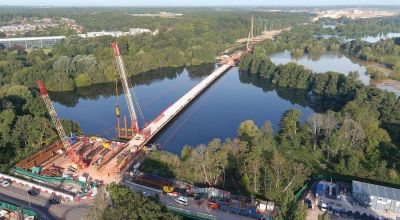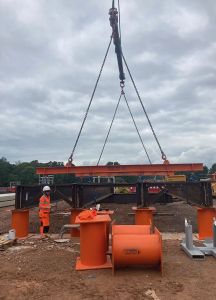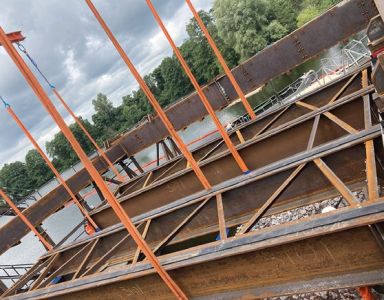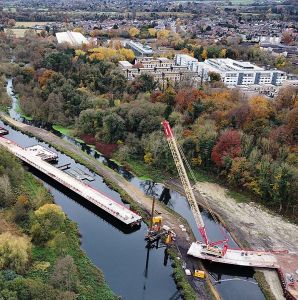HS2 Colne Valley Viaduct temporary works
Article in NSC March 2022
Jetties provide viaduct access solution
Temporary steel jetties with a total weight of 5,000t, spanning four lakes, are playing an integral role in the construction of HS2’s Colne Valley Viaduct.
Construction of the UK’s longest railway bridge is now underway as HS2 gears up to provide a new high-speed link between London and Birmingham. Forming an important part of the HS2 project, the 3.4km-long Colne Valley Viaduct will carry trains, travelling at speeds of up to 200mph, across a series of lakes and waterways on the north-west outskirts of London. Colne Valley covers some diverse countryside with areas of parks, green spaces and reservoirs. Along with the River Colne and the Grand Union Canal, the valley is a well-used public space offering recreational opportunities for visitors to enjoy.
In order to fit comfortably into this environment, the viaduct will be set low in the landscape, a design said to have been inspired by the flight of a stone skipping across the water. It will have a series of spans, some up to 80m-long, carrying the railway around 10m above the surface of the lakes, River Colne and Grand Union Canal. Haul roads for the construction of the viaduct generally follow the bridge alignment on land, however, were it spans lakes and wetlands, access is provided by temporary steel jetties that run parallel with the new structure. Measuring 12m-wide, the four jetties are being used to help with the construction of the viaduct piers as well as providing access routes over water for plant equipment and materials in areas that would otherwise be inaccessible.
Steelwork contractor Taziker Industrial is fabricating, supplying and installing 5,000t of structural steelwork for the jetties. Known as jetty A, B, C and D, these not inconsiderable temporary steel structures are 384m-long, 144m-long, 300m-long and 180m-long respectively. The jetties are being supplied to site in prefabricated steel deck modules, measuring 12m-wide × 9m-long. Using this form of offsite construction has meant a safer programme as there is less work undertaken over water, and a faster and more efficient method.
“We always have at least two modules ready to be installed at the jetty’s assembly points,” explains Taziker Managing Director Jarrod Hulme. “The modules are delivered as ladder frames, complete with crossbeams and bracings with each weighing 25t. Once on site, the modules are positioned on to trestle tables before being transported to their final jetty positions.”
Jetty C and D were installed last year, while A and B will both complete this year (2022). The construction of each jetty followed a similar installation procedure. The jetties were constructed sequentially with a crawler crane initially installing two x 900mm-diameter piles, which are up to 30m-deep. A single deck module was then delivered to the rear of the crane by a Self-Propelled Modular Transporter (SPMT). It was lifted and slewed 180 degrees by the crane and placed on the piles cap heads, which connect to the module’s front.
Once the initial module was installed, every subsequent unit was lifted onto the pile caps in a similar way, while the rear of each module has a bolted connection to the previous unit. Once a module was in place, the crane then installed a precast concrete deck unit, which was also delivered to the jetty by an SPMT in a similar manner to the module. The installed module and deck then provided the crane with a working platform for a further two piles to be installed in readiness for the next ladder frame and deck. This procedure was repeated until the construction reached the causeway at the other side of the lake.
Taziker’s works also included the installation of safety barriers, pedestrian walkways and guardrails along the length of the jetties. A total of 13 working platforms have also been built to enable the construction of cofferdams within the lakes, which in turn facilitate the construction of the viaduct’s piers. These working platforms, constructed in pairs and formed with slightly larger modules, measuring 14m × 9m, are connected to the jetty at approximately 50m intervals.
Positioned on a trestle, a module is made ready to be transported to its final position
Prefabricated ladder frame modules form the jetties
The working procedure and design of the jetties were agreed with Natural England to ensure the integrity of water and wildlife. The decking of the jetties has sealed joints and a cross-fall to a drainage system incorporating onshore silt traps and oil interceptors. Booms have also been placed in the water for emergency spill containment and extensive spill kits will be available on the jetties and in safety boats. All plant, as far as possible, is using biodegradable oils to minimise pollution risks and potential impacts on the ecosystem.
Mr Hulme says: “The construction of the viaduct in Colne Valley is a spectacular and essential part of the HS2 project. By supplying and installing a major temporary component, we have shown the quality and innovation steelwork can provide.”
Summing up, VolkerStevin Senior Project Manager Andy Dyer says: “Taziker are delivering works to an ever-evolving programme despite significant design changes being instructed. Its team has worked collaboratively to meet both the needs of us and our client. Its input into the design aspect of the project has created a value engineered scheme, assisting in producing a cost-efficient and practical solution.”
Once the Colne Valley Viaduct is completed in 2023, all of the temporary jetties will be disassembled and removed from their respective sites.
| Structural Engineer | Tony Gee & Partners |
| Steelwork Contractor | Taziker Industrial |
| Main Contractor | VolkerStevin |
| Main Client | HS2 |








